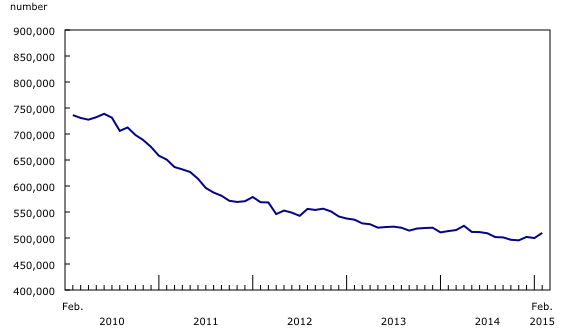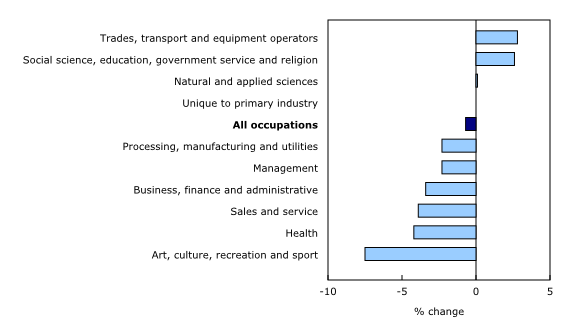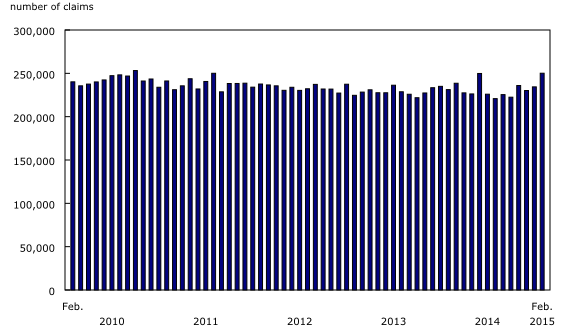Employment Insurance, February 2015
Archived Content
Information identified as archived is provided for reference, research or recordkeeping purposes. It is not subject to the Government of Canada Web Standards and has not been altered or updated since it was archived. Please "contact us" to request a format other than those available.
Released: 2015-04-23
The number of people receiving regular Employment Insurance benefits rose by 2.0% (+9,900) to 509,800 in February, following five months of little change. Compared with 12 months earlier, the number of beneficiaries was down slightly (-0.7% or -3,500).
In February, the number of beneficiaries rose notably in several provinces compared with a month earlier, with Alberta experiencing the largest increase (+15.6%), followed by Saskatchewan (+4.9%) and Prince Edward Island (+3.7%).
The change in the number of regular EI beneficiaries reflects various situations, including people becoming beneficiaries, people going back to work and people no longer receiving regular benefits.
Provincial and metropolitan area overview
In Alberta, the number of people receiving benefits rose a substantial 15.6% in February to 36,000. This was the fourth consecutive monthly increase for the province and the largest since May 2009. The largest increases for the province were among beneficiaries who last worked in occupations unique to primary industry (+51.8%); processing, manufacturing and utilities (+29.1%); natural and applied sciences (+28.8%); as well as management (+14.3%).
There was a marked 24.2% increase in Alberta's census agglomerations (CAs) and in areas outside census metropolitan areas (CMAs) and CAs (+21.9%). At the same time, the CMAs of Edmonton (+12.3%) and Calgary (+11.8%) also had more beneficiaries in February. See "geographical definitions" in the note to readers.
In Saskatchewan, the number of people receiving regular EI benefits rose by 4.9% to 11,600 in February, the third consecutive monthly increase. The province had a marked 19.2% increase in the number of beneficiaries who last worked in occupations unique to primary industry. There was a notable increase in the province's CAs (+15.0%), while the CMA of Regina was up 2.8%.
Compared with January, the number of beneficiaries in Prince Edward Island rose by 3.7% to 7,500 in February, the third consecutive monthly increase. There were more beneficiaries in the CAs (+3.7%) and in the outlying areas (+3.5%) of the province.
In Quebec, the number of beneficiaries rose by 2.5% to 154,300. There were increases in all six metropolitan areas, ranging from 6.0% in Sherbrooke to 1.9% in Montréal. The number of beneficiaries also rose in the province's CAs (+3.4%) and outside of the CMAs and CAs (+2.4%).
Between January and February, the number of people receiving benefits in Newfoundland and Labrador rose by 2.3% to 31,800, continuing an upward trend that began last November. In February, there was a notable increase in the metropolitan area of St. John's (+5.3%). For the CAs within the province, the number of beneficiaries rose by 3.5%.
In Nova Scotia, there were 27,200 people receiving regular EI benefits in February, up 2.2% from January and the third consecutive monthly increase. While the number of beneficiaries was virtually unchanged in Halifax, regions outside of the CAs posted a 3.1% increase in February.
In New Brunswick, the number of people receiving benefits edged up 1.1% to 32,200, continuing a gradual upward trend that began last fall. In February, Moncton posted a 3.8% increase, partly offsetting a decline in January.
In Manitoba, the number of beneficiaries edged up 1.0% in February to 13,500. There were more people receiving benefits in the province's CAs (+4.6%), while there was little change elsewhere in the province.
While Ontario and British Columbia had little change in the number of beneficiaries between January and February, this was not the case in some areas within these provinces.
Of the 15 metropolitan areas in Ontario, 4 had more beneficiaries in February, most notably Windsor, (+14.4%). At the same time, there were declines in a number of metropolitan areas, especially Oshawa (-8.3%), Hamilton (-3.9%), Guelph (-3.3%) and St. Catharines–Niagara (-3.2%).
In February, two of the four metropolitan areas in British Columbia had fewer beneficiaries: Vancouver (-3.0%) and Abbotsford–Mission (-2.7%). In contrast, there were increases in the CAs (+1.5%) and in areas outside of the province's CMAs and CAs (+1.3%).
Regular Employment Insurance beneficiaries by occupation
Compared with February 2014, the number of EI beneficiaries edged down 0.7% (-3,500).
Looking at EI recipients' last occupation, there were large decreases in the number of beneficiaries in several major occupation groups such as art, culture, recreation and sport occupations (-7.5%) and health (-4.2%) compared with the same month a year ago. In contrast, there were more people receiving benefits in trades, transport and equipment operators (+2.8%), as well as social science, education, government service and religion (+2.6%). At the same time, there was virtually no change in natural and applied sciences and in occupations unique to primary industry.
Employment Insurance beneficiaries in major demographic groups
Compared with January, the number of beneficiaries increased 4.0% in February among men aged 15 to 24, while there was little change for women in the same age group.
Among men aged 25 to 54, the number of beneficiaries rose 2.4%, the third consecutive monthly increase, while there was a slight increase (+1.4%) among women in the same age group.
The number of beneficiaries rose slightly in February for men aged 55 and older (+1.7%) and for women in the same age group (+1.2%).
On a year-over-year basis, the fastest rate of decline was among women aged 15 to 24 (-5.1%) and women aged 25 to 54 (-3.7%). There was little change for men in the same age groups.
The number of men aged 55 and older receiving benefits increased by 2.7% compared with 12 months earlier, and rose by 2.2% for women in the same age group.
Employment Insurance claims
Nationally, the number of EI claims increased 6.7% in February compared with January. The number of claims provides an indication of the number of people who could become beneficiaries.
Every province had more claims in February, led by Alberta, where there was a marked 29.4% increase. This was the second consecutive month with an increase over 20% for the province and the largest since February 2009. There were also notable increases in February for Prince Edward Island (+11.9%), Manitoba (+6.3%), Ontario (+5.8%), British Columbia (+4.1%) and Saskatchewan (+3.9%). Smaller increases were posted in the other four provinces.
Note to readers
Regular Employment Insurance (EI) benefits are available to eligible individuals who lose their jobs and who are available for and able to work, but cannot find a job. To receive EI benefits, individuals must first submit a claim. The number of claims provides an indication of the number of people who could become beneficiaries.
There is always a certain proportion of unemployed people who do not qualify for benefits. Some unemployed people have not contributed to the program because they have not worked in the past 12 months or their employment is not insured. Other unemployed people have contributed to the program but do not meet the eligibility criteria, such as workers who left their job voluntarily or those who did not accumulate enough hours of work to receive benefits.
All data in this release are seasonally adjusted. For more information on seasonal adjustment, see Seasonally adjusted data – Frequently asked questions.
EI statistics are produced from administrative data sources provided by Service Canada and Employment and Social Development Canada. These statistics may, from time to time, be affected by changes to the Employment Insurance Act or administrative procedures.
The number of regular EI beneficiaries and the number of claims received for the current and previous month are subject to revision.
The number of beneficiaries is a measure of all people who received EI benefits from February 15 to 21. This period coincides with the reference week of the Labour Force Survey (LFS). However, initial and renewal claims data are for the entire month.
EI statistics indicate the number of people who received EI benefits, and should not be confused with LFS data, which provide information on the total number of unemployed people.
Geographical definitions
A Census metropolitan area (CMA) or a Census agglomeration (CA) is formed by one or more adjacent municipalities centred on a population centre. A CMA, also referred to as a 'metropolitan area' in this release, must have a total population of at least 100,000. A CA must have a population of at least 10,000. See Standard Geographical Classification 2011–definitions for more information.
Data on Employment Insurance for March will be released on May 21.
Contact information
For more information, contact us (toll-free 1-800-263-1136; 514-283-8300; infostats@statcan.gc.ca).
To enquire about the concepts, methods or data quality of this release, contact Vincent Ferrao (613-951-4750; vincent.ferrao@statcan.gc.ca), Labour Statistics Division.
- Date modified:




